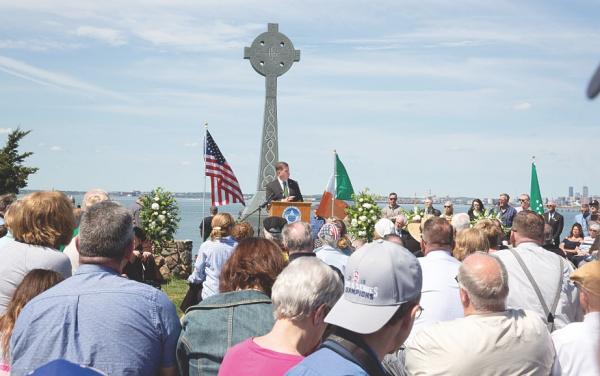March 4, 2020

Boston Mayor Marty Walsh spoke to a gathering of some 600 at the dedication of the Deer Island Irish Memorial.
Photo courtesy Bill Brett
An Gorta Mór – Ireland’s ‘Great Hunger’ – saw an estimated 1.5 million people die of starvation and disease between 1845 and 1852. Another 2 million emigrated, and many of them perished from the plagues they fled: thousands during Atlantic crossings, and thousands more on the shores of their destination. This monument commemorates the men, women, and children of the Great Hunger who sought deliverance in the New World only to perish while in quarantine on Deer Island in Boston Harbor.
Historical Background
Ireland was England’s first colony. Over centuries, an ‘ascendancy’ class, alien in race and religion, expropriated land and wealth, thereby breeding misrule, endemic poverty, violence, and war lasting into recent times. Theoretically part of the United Kingdom since 1801, Ireland remained a de facto colony, an agricultural resource that helped sustain England’s industrializing 19th-century population. Tariffs legislated by the Parliament in London devastated emerging Irish industries, leaving an expanding rural population to exist at subsistence level. The potato blight then destroyed their only food source. The Empire’s resources could have prevented mass starvation; instead, ineptitude, parsimony, prejudice, and a doctrinaire laissez-faire ideology that allowed food exports turned a crop crisis into a lingering famine. Government policy essentially starved the Irish people, by first creating scarcity, then prolonging it, effectively escalating death and mass emigration.
Deer Island Great Hunger Memorial
From Economic Immigrants to Famine Refugees
Between 1815 and 1845, nearly a million people abandoned Ireland’s ramshackle economy for North America. Thousands sought new beginnings in Boston and in New England factory towns. Most populated the poorest classes, suffering high mortality rates, and disproportionately occupying workhouses, jails, and asylums. Rapacious employers exploited those lucky enough to find work, while native working classes saw the immigrants as underpricing labor markets and stealing jobs. Nativist mobs publicly humiliated them, sometimes with violence.
Spring and summer of 1847 saw thousands of Famine refugees landing in Boston, many of them penniless, desperate, and clothed in rags. Hundreds arrived afflicted with “Ship Fever” – lice-born typhus – contracted aboard the ‘coffin ships’ that brought them across the Atlantic. Their numbers overwhelmed City institutions and threatened public health while stoking anti-immigrant nativism among alarmed Bostonians. In mid-May, the City Council formed a Committee on Alien Passengers, enforced laws requiring shipmasters to underwrite care for foreign paupers, and established a quarantine hospital on Deer Island for the immigrant sick.
Deer Island Hospital
Speedily adapting existing buildings, the city of Boston built its quarantine compound in days. Construction still in progress, the hospital opened on May 29, 1847, under the supervision of Dr. Joseph Moriarty and a team of fifty dedicated doctors, nurses, and support staff. Vessels packed with famine refugees immediately began arriving at the island where Calvin Bailey, the City’s Alien Passengers Inspector, identified paupers among the passengers and required captains to secure bonds indemnifying the City for their care. Port Physician Jerome Von Crowninshield Smith determined which passengers were afflicted with “malignant diseases” and transferred them to Dr. Moriarty’s care. A burial ground was located “near the north west corner of the most northerly hill on the island.” There, hospital steward James Turner buried the first three patients to die on the island: Mary Nelson, 6; Mary Connolly, 1; Mary Flaherty, 2.
By the year’s end, the hospital had treated 2,034 patients; nearly 300 had died, some 200 from typhus, which had also attacked hospital staff, sacrificing Dr. Moriarty himself. When the epidemic finally subsided in late 1848, the City Council entrusted the hospital to the House of Industry, which continued to service impoverished and disease-stricken immigrants throughout the Great Hunger and beyond.
Deer Island’s Great Hunger Legacy
Eight hundred and fifty men, women, and children perished on this island in the Famine years of 1847-1850, innocent victims of colonialism, racial prejudice, and imperial misrule. The Deer Island Great Famine Memorial commemorates these immigrant victims of a catastrophe induced by government policy that prioritized political power and private profit over poor people.
Since ancient times, the Celtic Cross, an icon of Irish heritage, has signified hallowed ground. This Cross marks as hallowed the ground of Deer Island where these Famine victims lie. They share this soil with peaceful Native Americans, starved in confinement on the island during King Philip’s War in the 1670s. Together, they attest to the crimes of colonial exploitation in Ireland, in America, and across the world. From this island, they cry out for an end to war, famine, and exile.
Text composed by John McColgan

